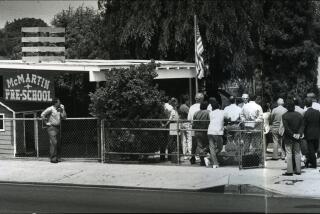Director Healing MacLaren’s Wounds
- Share via
Before Helen Maxwell became its director in 1986, MacLaren Children’s Center was a fearful place, a dingy institution plagued with allegations of over-medicated youngsters and indifferent care. The El Monte shelter for abused and abandoned children was described by some who knew it as a dumping ground, a holding tank and “the county’s oozing wound.”
Children sent to the center hated it so much they often tried to escape. Elizabeth Becker was so upset at being placed there for six weeks at age 15 that she says she would have committed suicide if she had had to go back. She particularly remembers the “jail-like beds that were bolted to the floor” and “a padded room where we were put when we were bad.”
But now the guard behind the bulletproof glass at the front door often banters with homesick shelter “graduates” who are trying to get back in. And when Maxwell, the eighth director of the county facility in 10 years, walks through the newly pastel-painted halls, children gravitate to her for a pat and a friendly chat.
As she showed a visitor around one day last week, an 8-year-old sadly reported he “might go to an aunt in Phoenix” after his court date on Sept. 4; a 10-year-old spontaneously asked if she could “stay here as long as I live”; and a teen-ager asked her opinion of emancipation, which would mean he could live on his own.
Maxwell, a pretty woman with a halo of curly hair, knew each child’s status. She discussed their situations in calm, reassuring tones, explaining, “We think it is important to treat each person with respect.”
Such attitudes, and Maxwell’s work at MacLaren, have “made the difference between night and day,” says Catherine Tracy, chief deputy director of the Los Angeles County Department of Children’s Service and one of Maxwell’s bosses. “MacLaren has become a real refuge and a home. I used to worry that kids would lose ground when they went there. Now I know their trauma will start to heal and they will also grow. I get lists from there of kids who simply don’t want to leave.”
The turnaround at MacLaren is making children’s advocates take a closer look at Maxwell and her innovations. She obviously has a method to which attention must be paid.
Not one to brag, Maxwell simply says she has “changed the focus of MacLaren” away from “custodial care” and has “de-emphasized as much as possible the shelter’s institutional nature by using environmental enhancements.”
From Dreary to Cheerful
Translated into real life, expert observers say, this means that in two years, Maxwell has transformed the center from dreary to cheerful. She has changed the staff attitude from punitive to positive. And she has set up “intervention” programs to help stop her charges’ “cycle of misery” the moment they walk through MacLaren’s door.
Maxwell prefers not to discuss what others say is the marked improvement she has made at MacLaren. But professionals who have watched and worked with her suggest she has succeeded because she is the first to approach her job “as a clinician, rather than as a bureaucrat.” Unlike her predecessors, she does not view the shelter as a holding tank for troubled kids headed to other homes, though technically it is. Instead, she sees it as an opportune spot to buttress the self-esteem of and introduce “humanizing experiences” to youngsters who are in such emotional distress that they cannot be placed anywhere else.
Some have been uprooted from their homes because of sexual or other physical abuse, drugs or sheer neglect; others have been rejected by their real or foster parents. The children may be psychotic, retarded or physically impaired. They may be so frightened that they ask to sleep in the well-lighted halls instead of in their own rooms. They arrive, traumatized, in pajamas or with just the clothes on their backs.
‘All Very Hurt’
From infants up to age 18, these youngsters display behavior reflecting their troubled pasts. “The more you’re hurt, the more you’ll act out,” Maxwell says, “and these kids are all very hurt.”
A pudgy boy with sleepy eyes comes up to her for a hug. Afterwards, Maxwell explains that he has round-the-clock guards to protect him from injuring himself or others during violent fits. Minutes later, it takes three strong men to hold the boy on a couch as he screams and flails.
Can anything help such kids? They are still children, after all, and “it is better to build a child than to repair a man,” Maxwell says, explaining that her “building blocks” take many forms, from the superficial to the profound.
“What really drove me crazy when I first got here were the dingy walls and the ugly metal beds,” she recalled. Working with United Friends of the Children, a nonprofit charity devoted to improving MacLaren life, Maxwell arranged for donations of handsome white platform beds with bureaus to match. Walls were painted with murals of animals happily at play. A room full of video games was installed to distract frightened children waiting to be admitted. A fully equipped exercise room, a gym with a performance stage and a state-of-the-art beauty salon also were installed.
Maxwell says the salon is “especially good for abused girls, who consider themselves ugly no matter how beautiful they really are.”
Library Donated
A free-standing, fully equipped library was donated through Friends of the Children by businessman Michael Milken, who also paid the librarian’s salary for five years, and there’s a new bus with a bathroom to take kids on outings.
There’s also an in-house clothing shop as classy as any in an upscale mall for the MacLaren youngsters, who, until Maxwell arrived, wore drab, county-issue uniforms every day. The shop, run by a trained counselor who happens to look like a fashion model, carries up-to-the-minute styles for both sexes, donated by top fashion firms. Children pay for their clothes with earned points--and there’s even a lay-away plan.
While some of the improvements may seem merely cosmetic, Maxwell says even the most superficial ones help children experience more “normal” lives. “These kids have lived in closets all their lives. We want to present, in some way, the real world to them.”
Ironically, the improvements Maxwell helped bring to MacLaren could have been accomplished earlier through Friends of the Children, a group now a decade old, says Nancy Daly, its founder: “But until recently, we were not warmly received--in truth, our help wasn’t wanted there at all. Then Helen came and everything changed. . . . Nobody can say MacLaren is awful now, as they did before.”
Stacey (Mrs. Henry) Winkler, the support group’s president and a member for 10 years, says Maxwell is the first MacLaren administrator who could work “harmoniously with the private sector. She treats us all with respect. She is, above all, a fine human being. . . . She is smart, savvy, a good businesswoman and completely committed to her kids. If I want to talk to her at 9 o’clock at night, I know I’ll find her at MacLaren.”
Maxwell may deal well with the private sector because she came from there. MacLaren is her first county job. After two years at Bennett College in North Carolina, she earned a bachelor’s degree in Spanish and social work at Cal State L. A., and a master’s degree in social work from UCLA. Then she worked for nine years with El Nido Services, a private, United Way-funded agency providing residential care and child and family counseling services.
Created Model Program
At El Nido, Maxwell says, “We were committed to developing creative and unique ways to bring professional social work services out into the community, to serve families and children who were abused and abusing, or who were stressed out and potentially abusive.” While there, Maxwell created a model program and was director of clinical services for the resulting three-year demonstration project that delivered full-time, church-based counseling services to inner-city families. It was so successful it still exists, though its original research funding has ended.
Barbara Solomon, USC dean of Graduate Studies, collaborated with Maxwell on the community outreach project, whose “most important aspect . . . was helping people who had been oppressed by (bureaucratic) systems to deal more effectively with those systems. All through the project, Helen taught her clients how not to accept bureaucratic restraints. . . . The perspective she had when she walked into MacLaren was that bureaucracy should not be allowed to impede you from helping people to perform more effectively.”
But Maxwell’s work isn’t done. It is obvious from a day spent with her on the job that she must tread lightly in some areas where she probably would like to stomp her delicate feet. Her full- and part-time staff of about 450 includes 15 teachers from the county education department; a large residential care staff employed by the Department of Children’s Services, the primary agency operating MacLaren; a preschool teacher from Plaza de la Raza and many more.
‘Now Blended’
Maxwell admits it is not easy for workers from so many different county departments to function as a cohesive unit. In the past, each agency’s employees tended to stick together. “We have now blended,” she says, “because our primary goal is to work for the children, no matter where we come from.”
It is also obvious that some employees are not as highly trained as she would like. Maxwell proudly introduces those who hold advanced college degrees or are working on them or who are simply “excellent people” whom she is encouraging to go further in their careers.
As for the youngsters, her therapeutic plan for them is to offer all the assistance possible. “We do everything we can to help . . . from the very moment he comes in, up to and including giving each new child a MacLaren teddy bear. From then on, we try to give each child independent components of good experiences and counseling that he or she can build on . . . If we don’t get to build much because the kid leaves to go somewhere else, at least we have given him something he can take along . . . “
Mareta Reyes, the preschool teacher, puts it another way. “Each of us has happy memories from when we were little. But these kids don’t. That’s part of what we’re trying to give them, so that when they will leave here, maybe they will have a few good memories. . . .”
More to Read
Sign up for Essential California
The most important California stories and recommendations in your inbox every morning.
You may occasionally receive promotional content from the Los Angeles Times.










